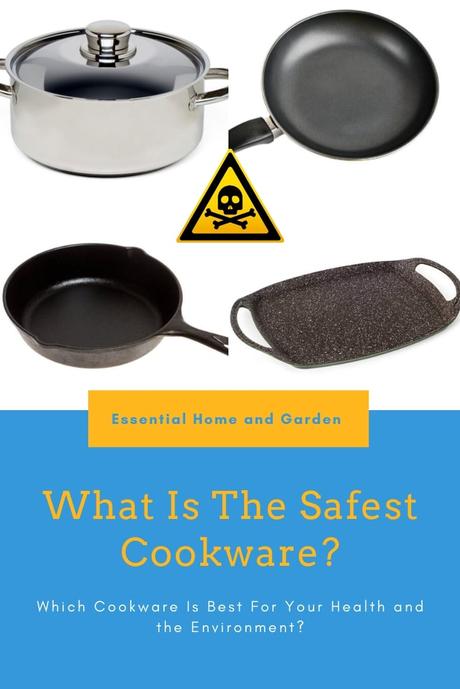Cooking beautiful nutritious food for your family can be a source of pride and enjoyment in your day. But if you're a regular home cook you should probably give your kitchen pots and pans a second look to make sure you have the safest cookware type. Most people have had at least one set of cookware that was 90% whatever was available and cheap when they needed it.
That's great. It's wonderful to be able to find kitchen appliances and cookware affordably. The problem is that not all cookware is created equal, and that includes that not all cookware is equally safe.
Depending on what materials your pots and pans are made from, and how you use them, you might have unwanted toxins in your food.
Knowing what cookware is safest, and how to use it to maximize that safety, is a fantastic way to help keep your family safe and healthy.

Using safe cookware can also minimize your risk of long-term health complications.
With that in mind, we've taken a look at a wide variety of different types of cookware and the studies on their performance and safety. We'll evaluate the problems and benefits of each type, and discuss how they can be used most safely.
We'll also note any environmental issues with each type of cookware. As we find types of cookware that are especially safe or especially unsafe, we'll talk about that too. Or, if you're looking for a faster guide to non-toxic cookware brands, this article can help.
Let's get started!
Disclosure:It is important you understand that we may receive commissions when you click our links and make purchases. However, this does not impact our reviews and comparisons. All opinions are our own we pride ourselves on keeping our articles fair and balanced. For more info see our disclosure statement.Cookware Type Comparison Table
Use this summary table to get a quick overview of each cookware type we have researched.
Keep scrolling past the table for in depth information.
Cookware Types and Their Health Impacts
Cast Iron

Cast Iron an old form of cookware. Cast iron pots and pans were commonly used in the Middle Ages, and have been used ever since. While this is a type of cookware that goes in and out of popularity, it's generally not very hard to find high-quality cast iron cookware.
Cast iron is also incredibly versatile. This is a type of pan that you can use to sauté some vegetables, mix in noodles and protein, and pop the pan in the oven to bake.
Cast iron fry pans are some of the most common, but you can also find large pots and 'Dutch oven' pots designed for baking your food.
Outside of health and the environment, the biggest downside to cast iron cookware is that it tends to be very heavy. Larger pots and pans can also crack your glass top stove if you drop them, or bang them around.
Health Impacts
Cast iron is considered one of the healthier cookware options out there. Cooking in cast iron does add some iron to your diet, though the amount that's added is unclear.
Cooking in cast iron can be very beneficial for people with mild anemia, and iron cookware is being used to address anemia in developing countries across the world.
However, excess buildup of iron can also be a problem, so you should avoid cast iron if you have ever had problems of iron toxicity, or have a health condition that makes high levels of dietary iron more dangerous.
Cooking acidic foods like tomatoes or vinegary foods can increase how much iron leeches into your food.
Cast iron can also be 'seasoned' with oil to become non-stick. A non-stick cast-iron surface can significantly reduce the amount of fats and oils in your diet, but it does take some work to maintain.
Follow the instructions that come with your new pot or pan to season it.
Environmental Impacts
Cast iron cookware is also considered very green and environmentally friendly. As with any metal processing, there is some energy and fuel consumption needed to heat the iron, and it's not emissions-free.
However, cast iron cookware is incredibly durable. You can easily expect to pass cast iron cookware down through your family for several generations before it needs to be replaced. Cast iron can be made from recycled iron, and often is. It can also be melted down and turned into something else or turned into new pots and pans.
Overall, this is a very low-impact type of cookware.
Stainless Steel Cookware

Stainless steel cookware is very easy to use and equally easy to maintain. It's not non-stick, so you can get food stuck to it a little more easily than some other types of cookware.
But it also distributes heat well, can handle high temperatures.
It's common to see stainless steel cookware advertised with a copper or aluminum core. That's because copper and aluminum are more conductive, which helps the cookware heat a little faster.
It's very durable and relatively lightweight. Stainless steel cookware is usually relatively easy to store. It's widely available and can be found in almost all shapes and sizes of cookware.
There are some concerns with stainless cookware, but it's one of the healthier options, and can also be one of the more sustainable options. Here are some of the best sets if you're looking to get more stainless steel cookware.
Health Impacts
The main concern with stainless steel is that it can leech nickel and chromium into your food.

Like with cast iron, acidic foods and especially tomato sauces can leech larger quantities of the metals into your food, especially with an increase in cooking time or temperature.
Stainless will also leech some iron into your food, similar to cast iron. However, like with cast iron, the amount of iron varies and isn't well understood.
Of the three, nickel is probably the most dangerous and is associated with several long-term health complications, including skin dermatitis.
Environmental Impacts
Stainless steel itself has a moderate environmental impact. It's better than some options, like non-stick, that require treatment with chemicals and have more different components.
But, aluminum core stainless cookware still has some of the environmental problems that plague aluminum (aluminum cookware can be made very sustainably, but often isn't. More on that later).
Copper core stainless cookware is generally considered more sustainable, and only slightly less environmentally friendly than cast iron cookware.
Many of the best rated cookware sets are made from stainless steel.
Non-Stick Cookware
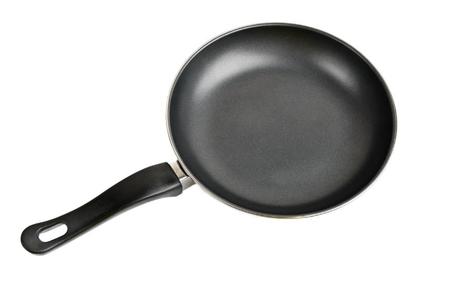
In this section, we're focusing on non-stick cookware that is non-stick because of a specific coating rather than the properties of the materials themselves. That excludes ceramic coatings, enamel coatings, and cookware that develops some natural non-stick like cast iron.
Instead, we're looking at things like Teflon non-stick coatings and other non-stick coatings
Generally, these coatings are relatively similar, but they do vary in durability and how effective they are. Non-stick cookware is some of the most common cookware out there. It's easy to find, and usually has a lower sticker price than some alternatives.
However, those coating generally wear down over time and can flake into your food. The pots and pans underneath the coating vary a lot in quality but often aren't very functional after the coating has started to wear away.
While this is a common and affordable kind of cookware, it's more expensive than other alternatives over the long run because of its low durability.
Health Impacts
Polymer non-stick coatings have been shown to have a negative effect on the health of people who use them, particularly when they start to wear out or flake. As a result, newer formulations come out constantly, but it's unclear whether any new formulation is healthier than older versions.
While non-stick is more of an issue in the long-term for most people, there are a few cases where a more acute and immediate adverse health reaction have been reported.
These coatings are probably the least healthy option for cookware. However, the exact health effects, and their severity, varies widely.
For more information check out our article on the best non toxic cookware brands.
Environmental Impacts
Polymer-based non-stick coatings are also incredibly hard on the environment.
All stages of coating production is resource-intensive, and many have very high rates of emissions, adding to the greenhouse gas burden on the planet.
Titanium
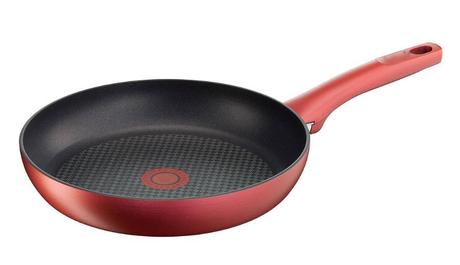
Titanium cookware is not made from 100% titanium. It's usually a thinner titanium coating on cookware that is made from stainless steel, aluminum, ceramic, or some combination.
The titanium core in non-porous, which means that you don't have to worry about other metals making it through the titanium coating and into your food.
Titanium disperses heat well, doesn't flavor or significantly alter your food, and is naturally non-stick. It's easy to clean and maintain and isn't very heavy. Titanium is a popular choice for foodies and anyone looking for easy-care, durable, cookware.
The internal cores are less important, although you should pay attention to the heating limits and properties of each option. Ceramic isn't quite as versatile as stainless in some respects while being better for other kinds of cooking.
Another concern is that you can't use metal utensils with titanium cookware. Metal utensils can scratch the titanium, reducing its durability and increasing wear.
Health Impacts
Well made titanium cookware doesn't have a significant impact on your health. It's easy to care for, nonstick enough that you can reduce your fat intake slightly, and non-porous and doesn't leech into your food.
It's also acid resistant and doesn't corrode, making this one of the healthiest options for working with tomato sauces and other acidic foods.
Environmental Impacts
Titanium cookware is generally considered environmentally friendly. However, it can be hard to re-purpose the cookware, and its durability largely depends on its care.
Ceramic and Ceramic Coated
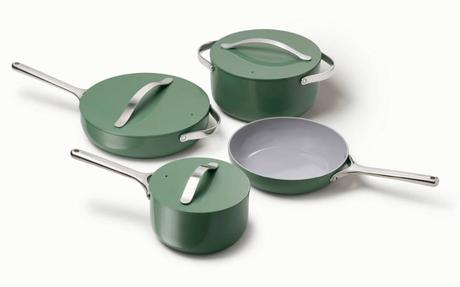
Ceramic cookware is both made from entirely ceramic materials, and ceramics can be used as a coating over metal cookware for a variety of reasons.
Ceramic cookware is very durable but can be vulnerable to chipping or breaking if dropped.
Ceramic also doesn't deal with massive temperature changes well, so you can't expect it to go from the refrigerator to the oven without having problems.
That's part of why ceramic coatings are often easier to find than full ceramic cookware. Just the coating is a little less temperature-sensitive, while still offering high abrasion resistance. Most ceramic cookware is very smooth and is easy to clean and care for.
Ceramic isn't truly non-stick, but it is very similar.
Health Impacts
The biggest health concern with ceramic cookware is that it can leech lead into your food if it's not completely lead-free. You need to make sure the ceramic itself, and any glaze that might have been used on the cookware, is all lead-free.
Lead has a host of long-term consequences, especially from early exposure. It can cause neurological damage over time. It also associated with cancers, dementia, and a range of other conditions and signs of ill health.
Environmental Impacts
Ceramics themselves have a very low environmental impact. However, they can be a slightly higher impact depending on the firing method used by the manufacturer. If the ceramic cookware is covered in a glaze or enamel surface, the environmental impact of that can also vary widely.
Aluminum
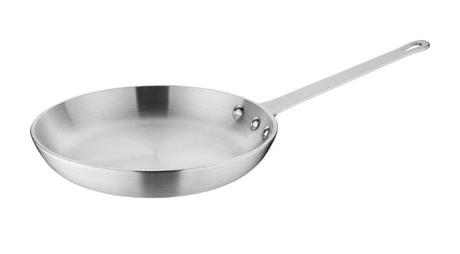
Aluminum cookware is generally very lightweight, affordable, and relatively easy to care for.
It's not quite as hard as stainless but is better at conducting heat. Aluminum cookware is often considered somewhere between stainless and copper cookware.
It's a highly abundant metal on earth and is naturally occurring in most of your food anyway. You're already eating small amounts of dietary aluminum, which is generally considered safe.
You'll also commonly find aluminum used in cookware with another coating on top. Coatings like titanium, stainless steel, and even copper can improve your cooking surface, while also taking advantage of the natural properties of the aluminum.
Aluminum is relatively reactive, however. Aluminum cookware can contribute a metallic taste to your food, especially acidic foods. This isn't the cookware you'll want to use for tomato sauces, making pickling brines, or other acidic meals.
Health Impacts
Aluminum is generally considered safe in small quantities, but there have been some studies showing that a higher amount of dietary aluminum causes a host of negative effects. The health consequences are potentially wide-ranging, from an increased incidence of Alzheimer's, some cancers, and many other adverse health consequences.
However, those consequences aren't entirely well known. There is also very little agreement as to how much aluminum is safe, and whether the dietary aluminum added by using aluminum cookware and aluminum foil is significant enough to matter.
Environmental Impacts
The environmental impact of aluminum varies quite a bit. It can be mined safely and with minimal environmental impact, and it's one of the most widely available metals on the planet.
Aluminum is also highly recyclable, which means that it can be made into new cookware, or other materials after the cookware itself wears out.
However, the aluminum industry doesn't always follow good environmental practices, and many people don't know that they can often recycle aluminum cookware.
Hard-Anodized
Another form of aluminum, this one is harder, usually more durable, and less likely to dent or get scratches. Like other aluminum, hard-anodized aluminum is relatively easy to care for, lightweight, and usually long-lasting.
The main difference between these two forms of aluminum is that hard-anodized aluminum has a protective coating that prevents the surface from being reactive. Hard anodized aluminum doesn't contribute any metallic flavor to your food.
The biggest use downside to hard-anodized aluminum cookware is that, like many non-stick options, hard-anodized aluminum is never dishwasher safe.
Health Impacts
Hard anodized aluminum isn't reactive, which some experts think reduces the risks of aluminum leaching into your food. However, since the risks and effects of high dietary aluminum are still not entirely well understood, it's hard to evaluate those claims.
In general, hard-anodized aluminum is the better choice for taste and durability reasons, but it's not clear whether it's healthier, or worse than regular aluminum cookware.
Environmental Impacts
The environmental impacts of anodized aluminum are similar to those of aluminum, although there is an additional processing step to create the anodized coating.
Copper
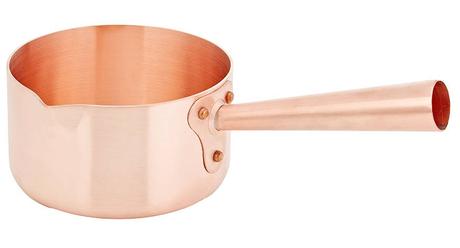
Copper is one of the most popular materials for cookware. It's attractive on its own, highly durable, and conducts heat much better than stainless steel cookware. It's even more conductive than aluminum but comes with a higher price tag.
In this section, we're going to look at copper cookware specifically, and then look at copper-coated cookware in a separate section. While there are a lot of similarities between the two, they aren't entirely the same.
Copper is a medium weight metal, it is relatively recyclable, and high-value metal, which means that there are usually recycling or selling options available if you decide to move to a different set of cookware.
Copper is also used as an internal component in some other styles of cookware, especially in stainless steel cookware and titanium cookware.
Health Impacts
Copper is already naturally occurring in some foods. However, your body needs a very small amount of dietary copper in your system, and getting too much can cause a problem.
It's unclear how much copper leeches into your food as you cook, and how much acid makes an impact on copper leaching into your food.
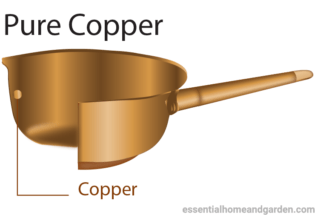
Some copper cookware is coated with a protective layer to make sure that there isn't any copper leaching. However, while those protective coatings are common, they aren't always as durable as the copper underneath, and not all copper cookware will have those coatings.
Untreated copper is not considered safe. It's reactive and will get into your food. Since you don't need much, added copper can cause a wide range of adverse health effects, though true, acute, copper toxicity is rare.
Environmental Impacts
Copper extraction isn't great for the environment, but your copper cookware isn't going to contribute significant demand to the already high-demand copper market.
Overall, copper cookware is very environmentally friendly because the copper is so conductive.
Because it makes heating your food very quick and easy, you'll need less energy to effectively cook your food. Over time, those modest daily energy savings are very significant, especially if you take good care of your copper cookware so that you don't have to replace it.
Copper Coated
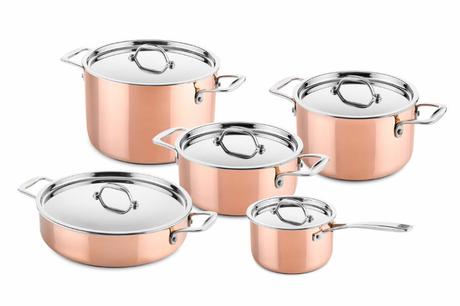
Copper coated is often used to refer to two different types of copper cookware, cookware that is made from copper which has been coated with another metal, and cookware that uses something else, but which has been coated with copper closer to the food, and then coated again with a protective layer to prevent the copper from being leached into your food.
These types of cookware are popular because they're attractive, incredibly durable, and designed to cook your food quickly and incredibly easily.
They have a lot of the same properties as plain copper cookware (that we've already discussed) but copper cookware that mentions a coating is often safer.
If you're looking for good, healthy, copper cookware sets, here is a list of some of the best options.
Health Impacts
Coated copper cookware is considered safe, as opposed to uncoated copper cookware. There should always be at least one layer of material between the copper in your cookware and your food.
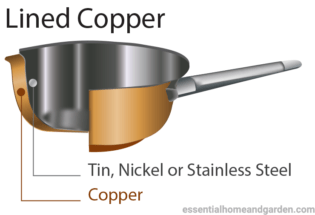
However, if the coating is nickel (which is quite common), or a delicate coating that wears down over time, you may have additional health impacts from the coating in place of the copper.
If the copper coating wears off, you're likely at risk for the same health impacts as uncoated copper. Since the quality and content of coatings varies quite a bit, you're better off looking at the specific health effects of the coating.
We've already discussed nickel, stainless, and several of the other materials that are commonly used to coat copper.
Environmental Impacts
The coatings used on copper usually are not significantly more environmentally detrimental than the copper itself. Copper cookware will still have the same thermal benefits when it's coated, so you'll still get the energy benefits of using copper cookware.
Glass Cookware

Glass cookware is one of the most popular options for durable bakeware. It's great for casseroles, brownies, and all kinds of other delicious baked goods. Thermal-resistant glass is generally dishwasher safe, but it doesn't handle the focused heat and intense heat changes of a stove. While there are some specialty types of glass cookware that can be used on the stove, they're less common.
Glass is easy to wash and maintain. It's relatively non-stick, it's non-porous, and it's non-reactive. Very little cooking will cause a temporary or permanent stain on the glass.
However, glass is vulnerable to breaking if you hit it too hard against another piece of cookware, drop it, or cause thermal shock.
Health Impacts
Glass that is designed for cooking doesn't have any significant health impacts. It doesn't leech into your food, doesn't change the flavor of your food, and doesn't release harmful fumes. However, it also isn't so non-stick that you can avoid greasing glass cookware.
The one health impact you need to be worried about comes from thermal shock. If your glass cookware begins to discolor, or worse, breaks, any food that was in the cookware at the time shouldn't be considered safe.
Glass can release a variety of harmful fumes when it's heated improperly. Those fumes get into your food and taint it. Usually, there is a noticeable change in flavor, but even without a change in flavor the food that was in the cookware isn't safe.
Environmental Impacts
Glass has a relatively low environmental impact overall. The materials used to make most glass are available in high quantities (though the pigments used to color glass may be rarer). The main emission of glass processing is CO2. A fair amount of CO2 is released, but the environmental consequences over the life of the cookware are low.
Enamel Cookware
Enamel is another popular choice for cookware. The enamel itself is usually a coating over another material. It comes in a wide variety of colors, it's durable, and it's very easy to clean.
Enamel is more common on bakeware than on cookware designed for the stovetop, but both varieties are available. Enamel doesn't add any flavor or significantly change the texture of your food when you cook with it. It's also naturally very non-stick because it's a non-porous surface.
Enamel is often applied over cast iron to provide an easier to maintain surface. Even when it isn't applied over cast iron cookware, it's used for similar kinds of cookware. Dutch ovens are an especially common use for enamel cookware.
Enamel cookware is also usually dishwasher safe, which cast iron isn't. Because the enamel surface is non-porous, cast iron and enamel cookware does not have the same effects, good or bad, as regular cast iron.
Health Impacts
There are relatively low health impacts that come with enamels. The enamel is non-porous and non-reactive, so it won't change the flavor of your food in any significant way. It doesn't contribute iron, nickel, or any other metals to your food.
You don't need to worry about overheating enamel like you need to worry about overheating 100% glass cookware.
However, like ceramics, you need to make sure that all your enamel cookware is lead-free. Lead in your cookware can leech into your food, just like it does with glazed ceramics that contain too much lead. The risk of lead exposure is incredibly low in enamel cookware, but some less than reputable manufacturers still use it.
Environmental Impacts
The environmental impact of enamel is incredibly low. Like ceramic and glass, the resources used are highly sustainable and very common, and it's a relatively low emissions product. Combine that with the extreme durability that allows enamel cookware to last a lifetime, and this is a low impact type of cookware.
Stone Cookware

Contrary to the name, stone cookware is not (typically) made from stone. Real stone is reactive and can have thermal shock issues. So, while some stone cookware was used by our ancient ancestors, that isn't what we're talking about when we refer to stone cookware today.
Instead, stoneware is more similar to ceramic and enamel. It's a very particular blend that is similar to both products in its properties as well as manufacture and content.
The reason stone coatings are called stone is because the finished appearance of the cookware is very close to fine granite or marble. It has very small particulates that are a different color than the rest of the cookware, and the whole thing has a rather mottled, natural stone-look finish. But it's also a medium gloss, so stoneware usually doesn't look entirely natural.
Stoneware is generally dishwasher safe, relatively non-stick, easy to care for, and relatively durable.
This flexible coating is used on roasting dishes, saute pans, pots, and a wide variety of other cookware.
Health Impacts
It shouldn't be surprising that there aren't any significant known health impacts of stoneware since it's so closely related to both enamel and ceramic. While enamel and ceramic are also both low risk in terms of lead exposure, the risk is even lower here.
The main problem with stoneware coatings, like all coated cookware, is that the coating might begin to chip or flake. That's exceedingly rare with this type of coating, but can happen if your pans are dropped, get banged together, or have some other impact damage that cracks the coating.
Even more so than enamel, stone cookware is very non-stick. It's relatively easy to reduce your fat intake by using stone cookware, which is a net health benefit.
Environmental Impacts
Since stone cookware is made from all-natural minerals and has a relatively low environmental impact in production, stone cookware offers very low environmental impact.
The Wrap Up
That's it! We've gone through a wide variety of the most common different kinds of cookware. While this list isn't exhaustive, we've tried to pick from a range of different options that are available in a wide range of styles, prices, and versatility.
While plastic cookware is available, we didn't rate it because the environmental impact and health impacts of plastic cookware are generally well known.
There are also other alternatives like bamboo cookware, which we didn't include because it has very limited cookware applications. Most people will need other cookware for most of their meals, not bamboo.
However, we hope that despite some gaps, this article answered your main questions when it comes to the health and safety of different common types of cookware. We've also looked at the environmental impact of each variety because we understand that both concerns are of pressing importance for many people.
Hopefully, now that you know which cookware is safest you'll be better prepared to pick your next family set of cookware.
